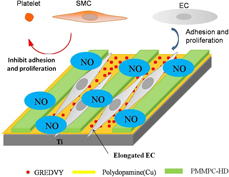Crossref Citations
This article has been cited by the following publications. This list is generated based on data provided by
Crossref.
Luo, Xiao
Yang, Ping
Zhao, Ansha
Jiang, Lang
Zou, Dan
Han, Congzhen
Gao, Pengyu
and
Yin, Benli
2020.
The self-organized differentiation from MSCs into SMCs with manipulated micro/Nano two-scale arrays on TiO2 surfaces for biomimetic construction of vascular endothelial substratum.
Materials Science and Engineering: C,
Vol. 116,
Issue. ,
p.
111179.
Luo, Xiao
Han, Congzhen
Yang, Ping
Zhao, Ansha
Zou, Dan
Jiang, Lang
Gao, Pengyu
Yin, Benli
and
Huang, Nan
2020.
The co-deposition coating of collagen IV and laminin on hyaluronic acid pattern for better biocompatibility on cardiovascular biomaterials.
Colloids and Surfaces B: Biointerfaces,
Vol. 196,
Issue. ,
p.
111307.
Zhang, Zhao-Qi
Yang, Yong-Xin
Li, Jing-An
Zeng, Rong-Chang
and
Guan, Shao-Kang
2021.
Advances in coatings on magnesium alloys for cardiovascular stents – A review.
Bioactive Materials,
Vol. 6,
Issue. 12,
p.
4729.
He, Junhao
Liu, Qiong
Zheng, Shuang
Shen, Runjia
Wang, Xinlei
Gao, Jingming
Wang, Qunsong
Huang, Jiale
and
Ding, Jiandong
2021.
Enlargement, Reduction, and Even Reversal of Relative Migration Speeds of Endothelial and Smooth Muscle Cells on Biomaterials Simply by Adjusting RGD Nanospacing.
ACS Applied Materials & Interfaces,
Vol. 13,
Issue. 36,
p.
42344.
Zhang, Zhao-Qi
Tong, Pei-Duo
Wang, Li
Qiu, Zheng-Hui
Li, Jing-An
Li, Hang
Guan, Shao-Kang
Lin, Cun-Guo
and
Wang, Hong-Yan
2023.
One-step fabrication of self-healing poly(thioctic acid) coatings on ZE21B Mg alloys for enhancing corrosion resistance, anti-bacterial/oxidation, hemocompatibility and promoting re-endothelialization.
Chemical Engineering Journal,
Vol. 451,
Issue. ,
p.
139096.
Li, Zhiyong
Zhang, Lu
Zhou, Lei
Li, Xin
Zhao, Yuancong
and
Wang, Jin
2023.
Tunable catalytic release of nitric oxide via copper‐loaded coatings on titanium nanotubes for regulating biological performance.
Biosurface and Biotribology,
Vol. 9,
Issue. 2,
p.
45.
Wu, Qiulian
Guo, Shuaihang
Liang, Xinyi
Sun, Wei
Lei, Jiao
Pan, Lisha
Liu, Xiaoli
and
Chen, Hong
2024.
Endothelium-Inspired Hemocompatible Silicone Surfaces: An Elegant Balance between Antifouling Properties and Endothelial Cell Selectivity.
Biomacromolecules,
Vol. 25,
Issue. 11,
p.
7202.
Fan, Duanqi
Liu, Xiaoli
and
Chen, Hong
2024.
Endothelium-Mimicking Materials: A “Rising Star” for Antithrombosis.
ACS Applied Materials & Interfaces,
Vol. 16,
Issue. 40,
p.
53343.
Yang, Yunong
Wang, Yanxia
Li, Yongjiang
Hu, Xuqu
Tong, Changgui
Xue, Chundong
and
Qin, Kairong
2024.
Micro-fluidic covalent immobilization of multi-gradient RGD peptides on a gelatin surface for studying endothelial cell migration.
Analytical Methods,
Vol. 16,
Issue. 46,
p.
7965.
Salehi, Ali
Rutz, Lena
Ulbrich, Konstantin
Stevens, Johanna
Guttmann, Markus
Worgull, Matthias
and
Cattaneo, Giorgio
2025.
Surface-modified gelatin hydrogel scaffolds with imprinted microgrooves: physical characterization and study on endothelial cell interaction.
Journal of Biomaterials Science, Polymer Edition,
p.
1.


